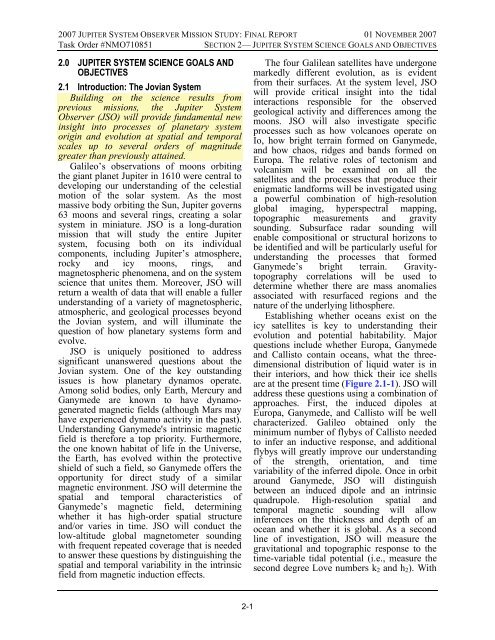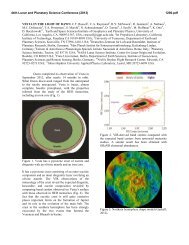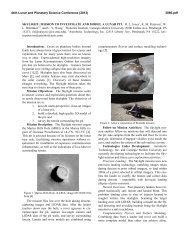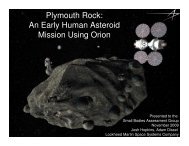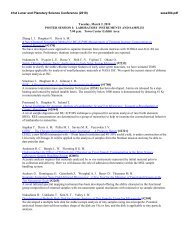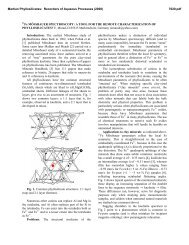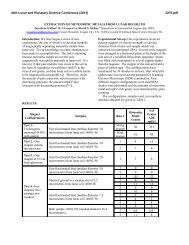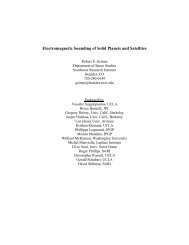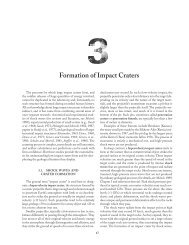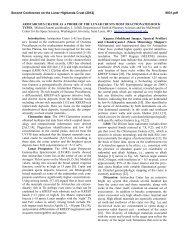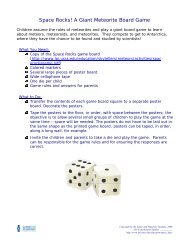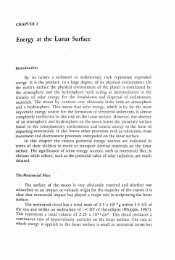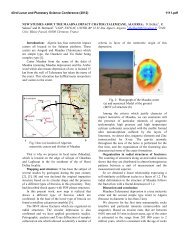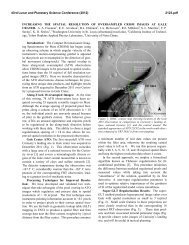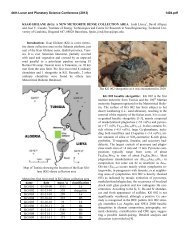Jupiter System Observer Mission Study: Final Report - Lunar and ...
Jupiter System Observer Mission Study: Final Report - Lunar and ...
Jupiter System Observer Mission Study: Final Report - Lunar and ...
Create successful ePaper yourself
Turn your PDF publications into a flip-book with our unique Google optimized e-Paper software.
2007 JUPITER SYSTEM OBSERVER MISSION STUDY: FINAL REPORT 01 NOVEMBER 2007<br />
Task Order #NMO710851 SECTION 2— JUPITER SYSTEM SCIENCE GOALS AND OBJECTIVES<br />
2.0 JUPITER SYSTEM SCIENCE GOALS AND<br />
OBJECTIVES<br />
2.1 Introduction: The Jovian <strong>System</strong><br />
Building on the science results from<br />
previous missions, the <strong>Jupiter</strong> <strong>System</strong><br />
<strong>Observer</strong> (JSO) will provide fundamental new<br />
insight into processes of planetary system<br />
origin <strong>and</strong> evolution at spatial <strong>and</strong> temporal<br />
scales up to several orders of magnitude<br />
greater than previously attained.<br />
Galileo’s observations of moons orbiting<br />
the giant planet <strong>Jupiter</strong> in 1610 were central to<br />
developing our underst<strong>and</strong>ing of the celestial<br />
motion of the solar system. As the most<br />
massive body orbiting the Sun, <strong>Jupiter</strong> governs<br />
63 moons <strong>and</strong> several rings, creating a solar<br />
system in miniature. JSO is a long-duration<br />
mission that will study the entire <strong>Jupiter</strong><br />
system, focusing both on its individual<br />
components, including <strong>Jupiter</strong>’s atmosphere,<br />
rocky <strong>and</strong> icy moons, rings, <strong>and</strong><br />
magnetospheric phenomena, <strong>and</strong> on the system<br />
science that unites them. Moreover, JSO will<br />
return a wealth of data that will enable a fuller<br />
underst<strong>and</strong>ing of a variety of magnetospheric,<br />
atmospheric, <strong>and</strong> geological processes beyond<br />
the Jovian system, <strong>and</strong> will illuminate the<br />
question of how planetary systems form <strong>and</strong><br />
evolve.<br />
JSO is uniquely positioned to address<br />
significant unanswered questions about the<br />
Jovian system. One of the key outst<strong>and</strong>ing<br />
issues is how planetary dynamos operate.<br />
Among solid bodies, only Earth, Mercury <strong>and</strong><br />
Ganymede are known to have dynamogenerated<br />
magnetic fields (although Mars may<br />
have experienced dynamo activity in the past).<br />
Underst<strong>and</strong>ing Ganymede's intrinsic magnetic<br />
field is therefore a top priority. Furthermore,<br />
the one known habitat of life in the Universe,<br />
the Earth, has evolved within the protective<br />
shield of such a field, so Ganymede offers the<br />
opportunity for direct study of a similar<br />
magnetic environment. JSO will determine the<br />
spatial <strong>and</strong> temporal characteristics of<br />
Ganymede’s magnetic field, determining<br />
whether it has high-order spatial structure<br />
<strong>and</strong>/or varies in time. JSO will conduct the<br />
low-altitude global magnetometer sounding<br />
with frequent repeated coverage that is needed<br />
to answer these questions by distinguishing the<br />
spatial <strong>and</strong> temporal variability in the intrinsic<br />
field from magnetic induction effects.<br />
2-1<br />
The four Galilean satellites have undergone<br />
markedly different evolution, as is evident<br />
from their surfaces. At the system level, JSO<br />
will provide critical insight into the tidal<br />
interactions responsible for the observed<br />
geological activity <strong>and</strong> differences among the<br />
moons. JSO will also investigate specific<br />
processes such as how volcanoes operate on<br />
Io, how bright terrain formed on Ganymede,<br />
<strong>and</strong> how chaos, ridges <strong>and</strong> b<strong>and</strong>s formed on<br />
Europa. The relative roles of tectonism <strong>and</strong><br />
volcanism will be examined on all the<br />
satellites <strong>and</strong> the processes that produce their<br />
enigmatic l<strong>and</strong>forms will be investigated using<br />
a powerful combination of high-resolution<br />
global imaging, hyperspectral mapping,<br />
topographic measurements <strong>and</strong> gravity<br />
sounding. Subsurface radar sounding will<br />
enable compositional or structural horizons to<br />
be identified <strong>and</strong> will be particularly useful for<br />
underst<strong>and</strong>ing the processes that formed<br />
Ganymede’s bright terrain. Gravitytopography<br />
correlations will be used to<br />
determine whether there are mass anomalies<br />
associated with resurfaced regions <strong>and</strong> the<br />
nature of the underlying lithosphere.<br />
Establishing whether oceans exist on the<br />
icy satellites is key to underst<strong>and</strong>ing their<br />
evolution <strong>and</strong> potential habitability. Major<br />
questions include whether Europa, Ganymede<br />
<strong>and</strong> Callisto contain oceans, what the threedimensional<br />
distribution of liquid water is in<br />
their interiors, <strong>and</strong> how thick their ice shells<br />
are at the present time (Figure 2.1-1). JSO will<br />
address these questions using a combination of<br />
approaches. First, the induced dipoles at<br />
Europa, Ganymede, <strong>and</strong> Callisto will be well<br />
characterized. Galileo obtained only the<br />
minimum number of flybys of Callisto needed<br />
to infer an inductive response, <strong>and</strong> additional<br />
flybys will greatly improve our underst<strong>and</strong>ing<br />
of the strength, orientation, <strong>and</strong> time<br />
variability of the inferred dipole. Once in orbit<br />
around Ganymede, JSO will distinguish<br />
between an induced dipole <strong>and</strong> an intrinsic<br />
quadrupole. High-resolution spatial <strong>and</strong><br />
temporal magnetic sounding will allow<br />
inferences on the thickness <strong>and</strong> depth of an<br />
ocean <strong>and</strong> whether it is global. As a second<br />
line of investigation, JSO will measure the<br />
gravitational <strong>and</strong> topographic response to the<br />
time-variable tidal potential (i.e., measure the<br />
second degree Love numbers k2 <strong>and</strong> h2). With


